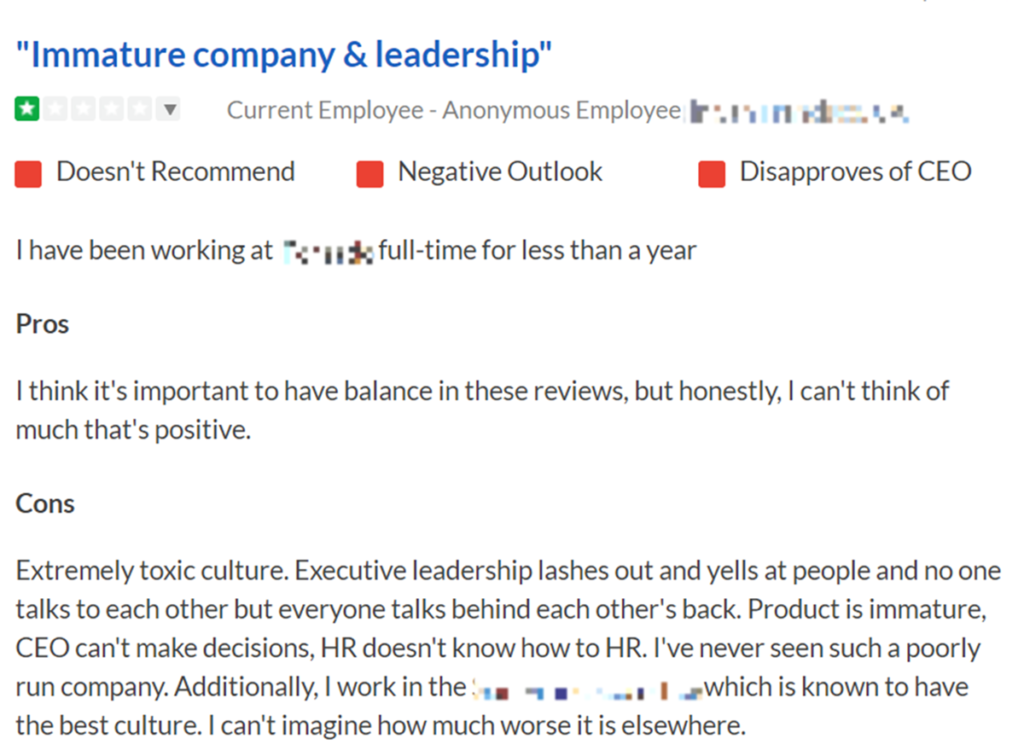I still remember it as if it was yesterday…
The date was January 4th, 2010, and it was a Monday morning.
This was not like any other Monday morning for me.
I had to gather all my strength just so I could get out of bed that day.
It felt like I had the real flu.
I was feeling really really sick.
On that day, I wished that I had an actual boss – so I could be fired, and put an end to this nightmare right there and then.
BUT that was not happening…
See, I was my own boss.
I started my freelance journey so that I will be my own boss.
However, that day, I wished I really had one.
Here’s what happened!
I was working on this huge client project that I had recently won.
It was a company in the US, one of my biggest contracts yet!
They hired an agency in New York City, and that agency hired me as their freelancer to complete that project.
Woohoo…that’s what I first thought!
But the reality was totally different.
The whole project was a nightmare, to begin with.
There were communication issues… The project scope kept changing. And the time difference didn’t help at all.
I worked 5 days straight.. 18 hour days each. It was grueling.
I even missed that year’s New Years’ Eve celebration.
But I couldn’t take it anymore. The stress was getting on to my nerves and this project was costing my health.
I decided that a change must be made.
I did something that was totally counter-intuitive.
I decided to fire the client.
At that moment, it was nerve-wracking to do.
It was the largest project I had secured, and the income was going to be really really good.
But I couldn’t take it anymore. I actually went through it.
Now looking back, firing that client was THE best thing I did.
Since then my life, career, and business have never been the same.
I went from being a freelancer to starting and growing an agency (Brainstorm Force) with 30+ employees.
And then to found a fast-growing WordPress software company and the best WordPress theme (Astra) with now with over 400000+ users.
All this happened after that fateful day – January 4th, 2010 when I fired that client.
Today I am sharing a list of 10 Client Types that you also MUST fire.
And perhaps, that will also be the best thing you could do for yourself.
Doing so will help you to focus on the really good ones, to grow your income and also help you soar your freelance career.
I will also share how to actually fire them once you have made the decision.
So, let’s dive right into it.
When and Why You Should Fire Them?
Firing clients can be nerve-wracking, especially when you are new in your field, or you have a very small client base.
Getting rid of them might have an impact on your income and your bottom line.
In the short-term, it might be painful and may not make sense to do so at that very moment.
But, there are red-flags you cannot afford to ignore.
When working with clients you will notice some things (some that are very subtle).
And these may be the tell-tale signs that you have to consider firing them.
a) It’s costing you more than what they pay you
Let’s say, you have a client who is on a fixed-price or a retainer model.
I am pretty sure that you have already set a monthly or quarterly contract that both of you agreed.
You might have also estimated and planned the time, effort and resources required for you to complete the project.
You have probably done this even before you have quoted the client.
Things go really well at the beginning.
The project is off to a great start.
But the client keeps changing terms, scope and you realize it is going to be longer than what you projected.
You notice that this client’s project is actually costing you more time, more resources and more of your own money.
This should definitely raise some warning bells.
Sooner or later it will become hard to manage their expectations, and it will become difficult to make this relationship profitable.
If you are losing money on every project from this client – that’s not a good course to stay on.
This is a definite sign – that you need to have a discussion with them and re-negotiate the contract – also, then set boundaries on what you can (and cannot) do for them.
Or the worst-case scenario is to fire them.
b) It’s causing you unwanted stress
If working with a client is causing you a lot of stress, and it’s affecting your health (like my story earlier) – that’s another really bad sign.
We became freelancers to enjoy the freedom and to course our own destinies.
We never wanted to do work that will hamper our health, right?
Let’s say, this client always has unrealistic deadlines and expectations…
They are mostly/always unprofessional…
Sometimes even abusive in the way they communicate…
All this will definitely have a toll on your productivity, mental well-being, morale, etc.
Let’s look at another scenario.
When working with this client – You are never excited to do their project.
Maybe you need 6 cups of coffee just to start doing their particular work.
And you complain to your friends- “I don’t enjoy this client, but the pay is good”.
That’s another red-flag.
We have the right and the freedom to choose projects that excite us and gives us a chance to improve our skills.
If it’s the opposite- then it’s time to call it quits with this client.
b) It’s causing other clients not to work with you
Maybe this client is really a good one and profitable too.
You are finding their projects less demanding than you thought.
But soon, you realize that you are spending a lot of time with this one client.
They are taking a lot of your time.
As a result, you are not able to grow your business.
This is another sign that this might not be the best scenario for you.
I know you are confused.
Why would a relationship that you enjoy and maybe profitable – not be good for me?
Let’s say, you have historically worked with mostly smaller clients -solopreneurs and one-man shops.
And occasional large clients.
You are suddenly receiving interest from larger clients with more profitable projects. (Because your skills have got better, your reputation has grown, and you are more in demand).
However, you are not able to win those new clients – because this existing client is taking up all your time.
It’s a tough decision, but it’s one you must take.
You have to make some changes.
You have outgrown some clients, and to move your business forward – you need to change them.
Perhaps, you can connect these clients with other freelancers who can work with them right now.
I have to be honest – this can be painful. You have strong relationships with them in the past.
But sometimes, you need to do the tough things to reach a better outcome.
So far, I have covered a few subtle but important tell-tale signs that show certain instances you can fire particular clients.
In the next section, I am going to dig deeper with 10 different client types that you must fire today.
And also how to spot each one of them.
The 10 Types of Clients You MUST Fire Today
1) The Late-Payer

This is the type of client that ALWAYS pays late or even worse – never pays.
If any client needs a lot of follow-ups, multiple notices, numerous phone calls, and reminders – just so you can get paid for the work you have already done – then that’s a bad sign.
I don’t think I really need to convince you about this.
But this is the first type of client you need to walk away from today.
No matter what you do – freelancing or running a small agency – you need a steady income.
You can’t sustain a career or business if the income source is erratic.
You are an expert in your field (that maybe one of the reasons you embarked on this journey).
You should be spending most/all of your time delivering on client projects.
And very little time in account receivables.
How to spot a “Late-Payer”?
- The most obvious sign of a “Late-Payer” is when you need to make repeated calls or send multiple emails just to clear one invoice. Then they repeat this for the next invoice, and the next one.
- If you notice that their payment patterns are inconsistent, and it’s hard for you to make a prediction when they will pay this month – that’s another sign of the “Late-Payer.
You will not see this type of client every day.
But all of us will come across them once in our lifetime.
The sooner you get rid of them – the sooner you can focus on earning more and growing your business.
2) The Bargain Hunter

This is the client who has to get 17 quotes to choose the best-priced vendor.
They are always hunting for the cheapest deal.
They will also let you know up front that they are shopping around, and sometimes they might reveal the names of all the competitors bidding.
They then hope to have each of you outbid each other.
They only want the lowest possible price and are less concerned with your experience, your skill-set or your reputation.
If you are shortlisted – they will ask you to jump on multiple calls to go over your proposal line by line. And for each line item, they want a discount!
How to spot a “Bargain Hunter”?
- They will ask you the cost/price even before they share the scope of work.
- They will often say “We are speaking with X number of freelancers” OR “We are shopping around for…”
- They will ask for a quote or written proposal before explaining the clear scope of the project.
More often than that – these clients end up turning into nightmares even if you win the contract.
You have spent years honing your craft, building your credibility, your reputation, and your skills.
At the end of the day, your relationship with your client is supposed to be a mutually beneficial partnership.
They need you for your service as much as you need their money to pay your bills.
If at any point, you will feel that this rule is violated, it’s time to move on and find another client.
Your goal is not to be the cheapest option but the best possible and best-valued option.
3) The Unethical Type

I am hoping I don’t need to convince you about getting rid of unethical clients, right?
You won’t meet them in your business every day. But once in a while, you might come across someone like this.
Their lack of ethics may not be clear at the beginning of your relationship.
But as you start working with them – you notice some disturbing patterns and unlawful requests.
They either ask you to do something that’s unethical or ask you to get involved in something totally illegal.
How to spot the “Unethical Type”?
- Always check for business’ reputation on sites like UpWork, G2Crowd, Yelp, Capterra, Glassdoor,etc.. If multiple other (vendors or suppliers or employees) have written long and nasty reviews about them – there is a chance they will treat you the same as well.
- Odd requests such as “Can I pay X amount in Cash, Y in Credit card, Z in other forms”. If a good client truly wanted your service – they will figure out a way to deal with you properly and ethically.
- Sometimes, it’s just that odd feeling you get. It’s hard to describe but as soon as you chat with them – you will have a weird gut feeling. Too often your gut instinct is correct.
Below is an example review from Glassdoor.com:

If this client gets caught in any type of scandal or bad publicity- then they will always bring down everyone associated with them (and that includes you).
This will hurt your reputation which you have taken months & years to build.
The money they pay you for the project isn’t worth the hassle you go through.
4) The Abusive Type

Not to be confused with angry or unhappy customers.
We have all been on the other side when we were angry with a service – whether it’s Amazon, your UBER driver or your local supermarket.
If you are a civil person – you express your dissatisfaction with the business – whenever you are angry.
They then do their best to solve the problem. That’s how most customer service situations are discussed and solved.
But the abusive customer is the opposite. They are much more than just angry.
They might yell or cuss or sometimes even physically threaten you.
How to spot the “Abusive Type”?
- After each call or meeting with them – you feel drained and exhausted. You do your best to avoid meeting them. That should be an obvious sign, right?
- Instead of pointing out the flaws in your work or project – they make it personal. If someone attacks or berates you rather than your work – that’s not a good sign either.
You will not see this type of client every day. This is also a rare occurrence.
But, if you don’t feel happy working with someone (whether it’s your customer or your client) – then I don’t recommend keeping that relationship alive.
Try to have a civil conversation with them and discuss the situation.
Try to de-escalate, but if they still don’t change – it’s time to say goodbye to them.
There are plenty of other clients who will treat you professionally and look at you as a problem-solving partner.
5) The Non-Believer

Have you ever worked with a client that wanted to hire you, but really does not believe in what you do or your ideas?
This client might have hired you because they thought it was the right strategy or the latest trend to invest in. They are investing in the latest strategy because everyone else in the industry is doing it.
Or they just wanted to “give it a try”, or “give you a try”.
They don’t know if your strategy or project will work but want to see if it works.
They probably even hired you at a steep discount to test out the waters.
Or asked you for a freebie to prove what you do works.
Here’s the thing with the “non-believer” types.
If and when their company has any type of financial issues – guess what is the first thing they will cut from their budget.
They will cut the projects or services that they have “little faith” in.
They will cut YOU.
How to Spot the “Non-Believer”?
- They want lots and lots of case studies. They want to speak to all your current customers. It’s OK to be skeptical about something, but if they treat it like a jury cross-examining a convict- that’s a problem.
- They hesitate to sign a contract, and they will often ask you to do a “free trial” before they decide to hire.
- They want you to present to 5 other people in the company. Their title (Owner/CEO) clearly shows they are the decision-maker, but they will make statements such as “Let me run this by X, Y and Z)
Your best clients are already convinced about your services (whether it’s content writing, graphic design, SEO,etc.), and they have hired you because you are the best fit for that service.
The “non-believers” are the opposite.
They are not sold on what you do, and perhaps not even you or what you are going to do for them.
So, don’t waste your precious time on this type of clients.
6) The Ignorant One

This is the client that has no clue how your service works (but has hired you anyway).
Perhaps they found you via a referral or online search, and they have decided to bring you onboard to turn things around for them. But they don’t know what is really involved in the type of work you do.
As soon as you start discussing the scope of work or deliverables – you realize that this client needs a lot of explaining and hand-holding.
This is the client that hired you for writing their content, and the only thing she cares about is ranking #1 on Google, and it’s all on you to figure out how to get it done. She doesn’t want to listen but just wants to rank on Page 1.
How to Spot the “Ignorant One”?
- They will say things like “Please take care of everything for me. I don’t want to know how it works”.
- Or they will say something like “My friend at ABC company was able to hire someone to do this project, and their business doubled. I want the same results. Can you do the same?”
- They will give you unrealistic deadlines. For example, they would want a website-design completed in 2 days or they would want a 5000-word article delivered in 24 hours.
- If the client has very little understanding or NO understanding of what you do, or what skills you have or what tools you need to get the job done – this is not a good sign for you.

If you are spending less time doing what you are doing really good at (your core skills) and more time on explaining things – then perhaps this is not a good client. It’s time to move on.
7) The Know-it-all Type

The exact opposite of the “ignorant type”.
This client knows more about your service than you ever do. (Or they pretend they know it all).
This is the patient who goes to the doctor for a checkup.
And then suggests the doctor a detailed diagnosis, a cure, and the prescription.
I know that’s an extreme example. But you might have come across a client like this.
Let’s say you specialize in SEO services, and you meet a client who is hiring you for an SEO audit or project. In your scoping discussions, the client shows that they know everything about SEO.
They have the knowledge, skills to do it all but they won’t do it themselves.
This client will list all the 200 ranking factors that search engines use, but their website is still performing poorly.
How to Spot the “Know-it-all Type”?
- Their common trait is to micromanage. They hired you but they don’t trust you completely to work independently.
- They are perfectionists, and they want all their requirements fulfilled even if they are hiring you for a relatively low price.
- They will brag a lot about their past and current accomplishments during all your conversations with them.
I am not saying – don’t work with knowledgeable clients, but if the client’s excessive knowledge gets in the way of you not being able to deliver your project – then this will become an issue.
Remember – there is a reason any client is hiring you.
It’s for your expertise and experience, and your ability to deliver on this experience.
8) The Indecisive Type

This is the client who takes forever to make a decision or worse makes no decision at all.
They want to make the right decision, so they ask you to come up with 3 packages.
You have spent hours & days creating 4 different proposals with painstaking attention to detail.
You also have spent hours on the phone explaining to them all the possible options.
But they still can’t seem to make a decision or keep delaying the decision to hire you.
This is the client who walks into 7 car dealerships on a Saturday, and yet has not decided which brand he wants to buy.
How to Spot the “Indecisive Type”?
- The common phrases they use are “let me think about this” or “I would like to discuss this with my XYZ” or “I’ll get back to you”
- They are hesitant to have phone calls or meet in person. They would prefer to keep all their conversations by email. Their email replies are very very long and they are filled with lots of questions.
- They will want you to send them multiple versions of the proposal or the quote.
- They will ask for many case studies, whitepapers, research reports, etc. They would also ask for all your samples and portfolio.
In most cases, you will be spinning your wheels with this client.
Even if they hire you – you will be spending more time explaining each and everything, rather than doing the actual work.
They will end up costing you more energy and time.
9) The “No-Respect” Client

This type of client either has no respect for you, or for your time or your skill-set.
You can clearly get this vibe from your very first interaction with them.
They just need to get the work done, so they end up hiring you.
They just want it completed at the lowest price.
And they will want you to always put their needs over yours.
They would want you to put all your focus and attention on them over all your other clients.
This type is entitled and they feel that they should get your time whenever they want to speak to you.
How to Spot the “No-Respect Client”?
- They will often get angry if you don’t reply to their requests right away.
- They will give you unrealistic timelines to work with. Even if they know your plate is full, they still want their project delivered tomorrow.
- They will say things like “I can hire people on Fiverr to do this for X” or “My nephew can do this for me for free, why do you cost so much?”
- They also don’t show up for meetings. They either cancel or reschedule all your discussions with them.
Working with these types over the long run is detrimental and might end up costing your other clients (who respect you for your skills and expertise).
So, best to avoid the “no-respect” types as soon as you meet them.
If one of your existing clients is like this – then it’s best for you to fire them as soon as possible.
Life is too short to work with anyone who does not appreciate or respect you!
10) The Ghost

Ghosting is a term synonymous with dating and recently an increasing trend in hiring.
However, it can also apply to your clients.
This is the client who was very enthusiastic at the beginning of your engagement.
They were always available for the initial discussion, and very excited to get started with you.
Then they disappear..
You don’t hear from them after you send a proposal.
Or you don’t hear from them when you want something from them to complete your project.
After numerous attempts via emails, calls, LinkedIn – all you hear is ….crickets!!
They might have reasons (some legitimate) for not contacting you.
However, I don’t think it’s OK. Nobody likes to be ghosted, and shouldn’t be.
How to Spot the “The Ghost”?
- They are always/mostly unavailable and it will require multiple follow-ups to get a response.
- They rarely respond to your emails or questions.
- They would be unwilling to set clear expectations, timelines, budgets. Most of the time they are enthusiastic in the beginning but their communication fades over time.
At the least, they should have the courtesy of letting you know – even if they have decided not to hire you, or if the project has been stalled.
If you are not receiving the response you desire from a client, then it’s not necessarily the best relationship to keep.
Should You Fire Them?
We just uncovered 10 different client types that you shouldn’t work with.
We covered the psychological traits, habits of these clients, and signs on how to spot each type.
However, before you go through the process of firing them – there are a few things you need to double-check.
Before you are ready to fire these clients – here are a few questions to consider.
a) Is it really the client, or is it my ego?
Ok, let’s face it. Conflicts will happen between you and your clients.
Anyone who has run a successful agency or freelance career will tell you that.
But, is that arising truly because of the client, or is it because of your ego?
Maybe the client said something, and you took it personally instead of it as professional feedback.
The client made some constructive feedback on your design or writing.
However, you felt hurt and felt that the client has insulted you.
It’s important to take a moment and assess this?
Is the client really a “jerk” or are you very fragile that you can’t take constructive feedback?
b) Am I in a good financial position?
Before you are ready to fire them – are you sure you can take the financial heat?
If losing this one client could cause a huge financial loss to your business, can you survive the windfall?
Do you have other clients that can support the transition?
Do you have a plan to replace the revenue?
These are serious questions you need to answer.
If you have a successful practice – then I am sure you can confidently replace them with new ones. But if you are brand new then it’s a different story.
But everyone’s situation is different. Are you able to afford that transition?
c) Did I thoroughly check the contract?
Large companies often have stringent legal procedures and contracts when dealing with external agencies and freelancers.
If you have a large client, you might have had to sign their agreement instead of the standard contract you send to everyone.
If so, it’s important that you double-check your termination clause.
Is there a termination fee/penalty for breaking the contract?
How much notice should you legally be giving them?
What about the intellectual property of the project?
What can you and cannot take with you if the project is stalled?
These are the questions you need to answer.
d) Can this be saved by proper communication?
Poor communication is responsible for the downfall of many relationships – personal and business.
Sometimes a conversation in person or a phone call might be able to clear things up.
Too often conflicts arise because of misunderstandings or miscommunications between two parties.
It is natural for us to assume that the other side is always at fault, and we are quick to jump to conclusions. That’s just human nature.
Maybe it was all your misunderstanding.
The client was not sure exactly how to deal with external vendors, and there is a learning curve.
Or there are procedures they need to follow with their accounting department.
There could be legitimate reasons why they did not show up for the last 2 client discussions.
Clarify it first before making the decision to fire them.
If you have already reached the end of the line with the client, and you know for sure that you have to break up with them – then move forward with the due course of action.
The Art of Firing Clients Smoothly
So, you have made the final decision to go ahead and fire the client.
There is no option but to move forward with cutting your business relationship with this client.
Fair enough!
In this section, I will show you how you can do that professionally.
But first…
The Don’ts of Firing Clients
Let’s quickly look at what you shouldn’t be doing.
You are a professional, and I encourage you to keep that in mind in all your client dealings.
In the age of online review sites and social media – one small smear campaign or a bad review from a client could hurt your business.
With that in mind – here are a few points to consider.
a) Don’t ghost them
We discussed this earlier. Nobody likes to be ghosted!
Some people think that ignoring your problems will soon make them go away.
This is never a good strategy.
Follow the Golden Rule and always communicate with your clients (both good and bad ones), and set up an opportunity to have a discussion with them.
b) Don’t be unprofessional
At the end of the day, your client might have abused you verbally.
This does not mean you should also do the same.
When breaking up with clients – it’s better to always take the high road.
Break the news to them in a professional way.
You are still a professional and your reputation always matters.
If you are mean to them or launch a personal attack – then it might make things even worse.
They might threaten you back or even take you down the road of legal action.
Be curt, be straight – but don’t take it too far.
c) Don’t hide behind your email
Most of us like to hide behind email or IMs such as Slack.
If you have had a long-lasting argument with the client – then don’t just send them an email or text message.
Do your best to have the conversation in person or on a call. (which we will cover in the next section). Set up a meeting to go over the agreement and have a conversation.
Even if you are ending the relationship- you want them to feel good and empowered to be moving on.
This is not always possible but you can definitely try.
How to Properly Fire Clients?
So, here’s how you can fire your clients gracefully and professionally.
STEP 1
Do your research on any of the pending projects you have with them.
Double-check the existing contract.
This will help you do an assessment of how much time you need to invest with this client before moving on.
Also, find out who else in your network can help them. Maybe it’s another freelancer or agency.
Be ready and prepared to give them recommendations when the time comes.
STEP 2
Schedule a short conversation.
If they are located in the same city as you, the best way to do this is to ask for an in-person meeting.
Otherwise, set up a skype/zoom call or a phone call.
STEP 3
Communicate the purpose of the meeting and get to it right away.
As discussed before – be curt, be professional and be straight.
The meeting shouldn’t take too long.
This is also not the meeting where you will be discussing other projects.
Here’s a conversation script you can use:
Feel free to adjust and modify this according to your situation.
“ Client A – I have enjoyed working with you & your team on XYZ projects.
I appreciate your business and the opportunity.
The reason for my meeting today is this.
Based on our last few projects and interactions – I honestly don’t think it makes sense for us to continue working together.
I have sensed that there have been some misunderstandings about our arrangements.
I take responsibility if I did not communicate things properly, and this is something I will continue to work on for myself.
However, I am no longer in a position to support your company as a client.
I am moving my business in another direction.
I will make sure that all our pending projects are completed by “X date”.
I will also make sure to send out the last invoice on “Y date” once the project is completed.
To ensure a smooth transition – I have also made a list of 3 other individuals that I feel would be a good fit for your company. Here they are.
You can reach out to them directly.
Or If required, I am happy to make an introduction, and ensure a smooth transition”.
STEP 4
Take a deep breath!
That’s it. You have successfully done it.
You have covered all your bases in firing this client.
- You thanked them and have told them it’s time to end the relationship.
- You were professional
- You did not waste any time on the blame game.
- You have reassured that all pending projects will be completed.
- And finally, you offered to help make connections.
Most clients will be reasonable enough to accept this approach.
You have done all the homework and have communicated from a place of empathy, not spite.
They will respect you for this. They might not even carry any hard feelings because of this.
You have set yourself up to leave on a high note.
You never know where they can help you in the future. Perhaps, they can refer you to another client in the future. You would never know otherwise.
Congratulations – you have successfully fired a client.
You can now move on to more fruitful clients that value you and your skills. You can work with clients who will pay you what you are worth in a timely manner.
It’s time to keep moving your business forward.
Wrapping It Up!
Identifying these 10 client types will help you soon to spend time only with suitable and profitable ones.
It’s time to keep moving your business forward, and you would be surprised how fast it can grow if you focus only on the right type of clients.
Are there other client types that I missed in this article? If so, let me know in the comments below.
Disclosure: This blog may contain affiliate links. If you make a purchase through one of these links, we may receive a small commission. Read disclosure. Rest assured that we only recommend products that we have personally used and believe will add value to our readers. Thanks for your support!






Very well done Sujay, good article. Thank you. Raffaele
Hello Raffaele,
Glad to hear that you liked the article. Cheers! 🙂
Hi Sujay
This is a really good article! I’ve never read anything like this and it’s so true what you wrote.
Best regard
Peter
Hello Peter,
Glad to hear that you liked the article! 🙂
Nice article, not sure it’s practical 🙂
Most people and customers belong to these types,
So we might find ourselves alone without customers.
We should always remember that customers are also living people
and serve them the best we can & have patience.
Of course when these are extreme & damage your business,
better give them up 🙂
Thanks, Sujay,
I follow & respect your work
also when not always showing it 😉
Hello Ahrale,
Thank you for your thoughts!
And glad to hear that you liked this article. Cheers! 🙂
Hi Sujay, hope you are the team are all well.
This is a great article. I’ve come across many of these types of people over the years. I think you’re right that if they exhibit the extremes of these behaviours that dealing with them is ultimately never productive. I love your suggested approach for how to go about firing them – I’ll have to remember this.
Hello Stephen,
Thanks for sharing your thoughts! 🙂
HI Sujay,
Thanks for the detailed article. I agree with you, there are all kinds of clients out there and some are more challenging than others with which to build and maintain healthy relationships.
Here’s something interesting. In my 30+ years of owning a business, I’ve never fired a client. If a relationship had become stressed I’ve found it was often due to lack of clearly defined rules and expectations on the outset. I took full responsibility to change this; it’s something I could control.
I learned that by making an adjustment and always entering a business agreement with clearly defined rules/guidelines, issues stated in the article rarely emerged. In the rare cases that they did, revisiting and discussing the terms or expectations usually solved the problem and a healthy relationship prevailed.
Having said this, I have experienced a couple of unreasonable clients. Again, I never had to fire them though.
Upon reviewing the expectations on both sides, if both parties are still not on the same page, both can agree to walk away from one another, no hard feelings. It’s a kind, gentle approach which doesn’t burn bridges. In fact, I’ve had a couple of clients return years after a “mutual departure”. They’re still with me today and we have a very healthy relationship.
In summary, an alternative to firing worth considering, is to review expectations and if a mutual ground can’t be reached, aim for a mutual departure.
Food for thought.
Keep up the good work!
Hello Gilles,
Thanks for sharing your thoughts. Much appreciated! 🙂